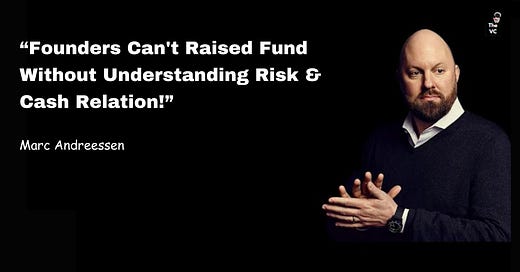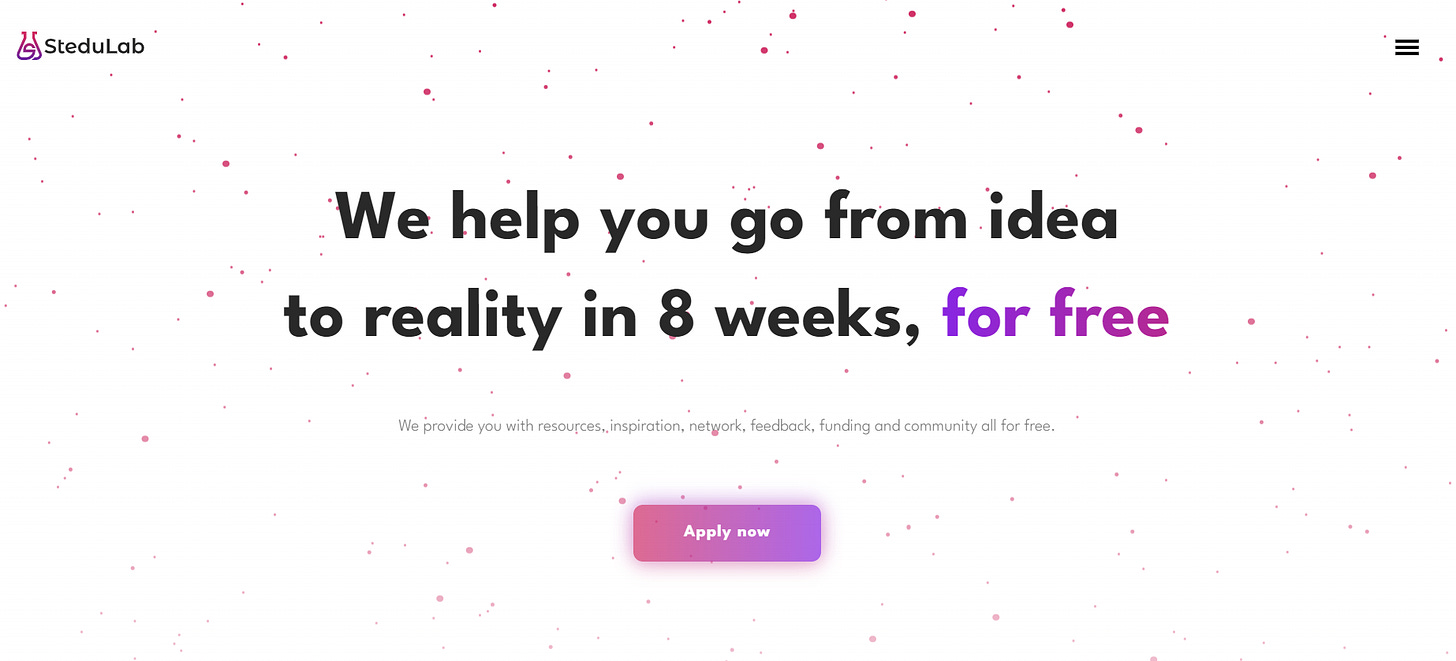Marc Andreessen: 'Founders Can't Raised Fund Without Understanding Risk-Cash Relation'| Running Great User Interview Using Y-Combinator Strategy | VC Remote Jobs and More
Understand Risk & Cash Relation To Raise Funding | Running Great User Interview Using Y-Combinator Strategy | VC Remote Jobs
📢 Today At A Glance
Focus On: Marc Andreessen: 'You can't raised fund Without Understanding Risk & Cash Relation'
Featured Article: 99% of Founders Make This Mistake In Conducting User Interviews.
Major News In Startups: A16Z raising $3.2B VC Fund & Billionaire Charlie Munger criticizes VC investment strategies
This Week’s Must Reading on Startups, Venture Capital & Technology
Venture Capital Remote Jobs & Internships: From Scout to Partner
🤝 In Partnership With: Stedu Lab
Turn Your Startup Ideas Into Reality With Stedu Lab 💡
Stedu Lab is an 8-week program for ambitious individuals who want to turn their ideas into reality in just 8 weeks.
😃 The purpose of Stedu Lab is to empower ambitious individuals and be their first supporter.
Stedu Lab is 100% free for everyone and does not take any equity, charge program fees, etc.
🌍 Open to all - students, professionals, dropouts, dreamers!
⏰ 8 weeks to turn your ideas into reality!
Marc Andreessen: 'Founder Can't Raised Fund Without Understanding Risk-Cash Relation'
Only 1% of founders successfully raise venture capital funding while 99% struggle, you know - what’s the one-line difference between the two of them?
Well, it all boils down to understanding the relationship between risk and cash. You see, those savvy 1% founders get it – they truly grasp how risk and cash flow intertwine. This understanding gives them the edge when pitching their startups to investors.
Picture it like this: they know the ropes, they speak the investor language, and they get the funding they need & 99% of founders failed to get this!
So, what’s this risk-return relationship about and how can it help to raise VC Funding?
Source: Google Images
So - the single biggest thing that most entrepreneurs are missing is both -
in fundraising and in running their startups is the relationship between risk and cash.
99% of founders often overlook the relationship between risk & raising cash and then the relationship between risk & spending cash.
If you are aware of the theory called Onion Theory Of Risk by Andy Rachleff, it says that -
as a startup (especially before Seed funding), you are just layer upon layer of risk. Even after you get your first round of funding, it’s not the money that makes those risks go away, it’s what you do with it.
Source: Google Images
So initially - You can think of a startup as having every conceivable kind of risk.
Risks like -
Founding Team Risks: Whether the founders will be able to work together effectively.
Product Risk: Can the team build the product?
Technical Risk: Suppose you need a machine learning breakthrough or something similar. Will you have something to make it work, or will you be able to achieve that?
Launch Risk: Will the launch go well?
Market Acceptance Risk: Will customers accept your product?
Revenue Risk/Cost of Sales Risk: Will a sales force be able to sell the product for enough money to cover the cost of sales?
If you have a startup in the consumer product space then - viral growth risk.
So a startup at the very beginning is just a long list of risks.
So - What only 1% of founders accomplish is peeling away each layer of risk from the initial fundraising round; where 99% fail to achieve this.
How Does This Work?
With each funding round, such as a seed round, as a founder, you can attempt to peel away the layers of risks, such as the founding team risk, the product risk, and perhaps the initial launch risk.
Again - if you are raising the Series A round, try to peel away the next level of product risk, maybe you can peel away some of the recruiting risk as you get your full engineering team built. Maybe you peel away some of your customer risk because you get your first five customers….
So the way you can think about it is, that you are peeling away risk as you go, you are peeling away your risk by achieving milestones.
As you achieve milestones, you are both making progress in your business and you are justifying raising more capital.
How Can You Pitch To Investors With This Edge?
If you are raising the pre-seed / seed (first funding round) - you can say that -
“With the amount of personal investment or from family friends - I have achieved the milestones and eliminated these risks. Now I am raising Seed round - Here are my milestones, here are my risks, and by the time I go to raise series A round here is the state I will be in.”
Then you can calibrate the amount of money you raise and spend to the risks that you are pulling out of the business.
You might be thinking that - everyone knows this but this is not true - 99% of founders failed to think systematically about how the money gets raised deployed and pitched to investors.
That’s why - 1% of founders stand to differ from the rest founders. They understand the risk and cash (raised & spent) relationship and use it in a systematic way to express to the investors.
That’s it!
You can watch the video by Marc Andresson - where he shared this perspective.
🤝 Advertise in The Venture Crew’s Newsletters
Want to promote your startup to my community of 14,000+ entrepreneurs and investors? Reply “advertise” and I’ll share my media kit.
Featured Article:
Running Great User Interview Using Y-Combinator Strategy
User interviews are indeed crucial for startups, serving as the initial stepping stone for founders. However, many entrepreneurs stumble at this pivotal stage, often without realizing it.
The most prevalent mistake that founder do ? — Discussing features with users.
Surprising, isn’t it? You’d think that explaining all the cool features of your product would win people over, but in reality, it often does the opposite. Here’s why:
Source: Google Images
The primary objective during the initial set of interviews is not to inquire about optimizing user flow or delve into specific feature details. Such questions can be distracting because users often think they know what they want.
Often — this types of situation can lead to the “horseless carriage effect,” where users request a faster horse instead of seeking a solution to the underlying problem.
Thus, it is important to avoid discussions about features as much as possible, as the requests from real users can feel compelling and difficult to decline. ❌
When a real user asks for a feature, it becomes challenging to reject their request, given the real problem they face.
However, through conversing with various users and understanding their problems, one can determine if the issue at hand is substantial enough to warrant building an entirely new product.
Sometimes — based on the insights gathered from the user interview, raises doubts about the existence of a significant problem. There might not be a problem significant enough to justify the creation of an entirely new product. 🫢
If you can’t hear about any major obstacles or flaws in the existing system. Unless a groundbreaking idea surfaces, interpret it as a discouraging sign.
However, this doesn’t mean — one cannot continue the research and talk to more people. Just because the first interview did not yield substantial results does not imply that others won’t encounter the same issue.
Typically, after conversing with around six to eight individuals, the information collection phase concludes.
It’s unlikely that significantly new information will emerge beyond this point.
Hence, it’s important to engage with diverse groups of people, including those from different backgrounds and perspectives.
Speaking to individuals with varying experiences, such as high school students, parents, and college students from different institutions, can provide valuable and distinct insights.
That’s it.
We also shared this on a medium platform - here is the link.
Join 7700+ Founders, VCs and startup Enthusiasts Getting Tactical To Build, Learn and Implement Startups, Technology and Venture Capital.
📰 Today’s Major News: VC & Massive Funding Updates
“Current AI-Investment Won’t Make Any Money”, Vinod Khosla Read Here
Billionaire Charlie Munger criticizes VC investment strategies Read Here
Andreessen Horowitz Plans to Launch a $3.4B Fund Read Here
Google Invested $2B in Anthropic Read Here
Seed deals are getting more expensive! Read Here
Subscribed To, VC Daily Digest Newsletter and join 6000+ Avid Readers For Daily Morning Venture Insights, Funding Updates And Startup Stories In Your Inbox. 🚀
🗞️ Weekday’s Read On: Startup, Technology & VC
The Math Behind Starting a Successful Software Startup Read More (Startups)
18 Mistakes That Kill Startups by Paul Graham Read More (Startups)
The top ideas in your mind by Paul Graham Read More (startups & venture capital)
How Do Investors Protect Themselves from Downrounds? Read More (Startups & Venture Capital)
AI Reaccelerating Cloud Growth Read More (AI & Startups)
💼 Venture Capital Remote Jobs & Internships
VC Analyst - Commerce Venture | US - Mail Here
Access fellowship - Commerce Venture | Remote - Apply Here
Investors Relation - Stepstone venture | Remote - Apply Here
Sustainability Analyst Intern - 5-season venture | Paris - Apply Here
VC Associate - Commerce Venture | US - Mail Here
Venture Associate - Plug and play tech centre | USA - Apply Here
VC Intern - DSG Consumer Partner | Remote - Apply Here
Venture Analyst - AngelList | Remote - Email Here
Join 100+ VC Enthusiast Community - VC Crafters - A Community For VC Enthusiasts To Learn, Collaborate, Network and Craft Path To VC.
📦 Share VC’s Newsletter
Refer a friend to gain access to our venture resources. 🎊
Get Venture Capital and Investors Database. for 4 referrals
Get Access To private Slack for 10 referrals
Get On a 30-minute call for 15 referrals ( To Discuss fundraising, breaking into VC funds, making a pitch deck, building a newsletter and others)
✍️Written By Sahil | The Venture Crew Team












